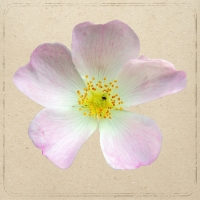

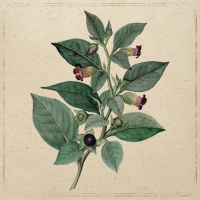
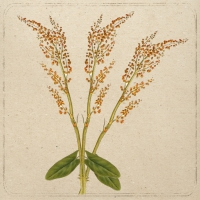
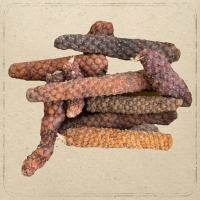

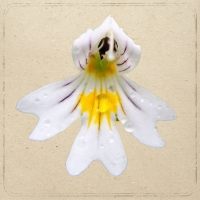


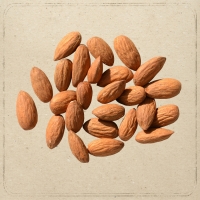

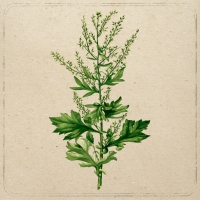


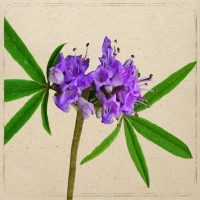
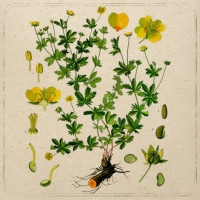
Hover over parts of the body or selection of medicinal remedies to hightlight illness with corresponding treatment
Further information about treatment benefits appears here.
Scroll through and tap on the selection of medicinal remedies to hightlight illness with corresponding treatment.
Further information about treatment benefits appears here.
Euphrasia
For the Eyes
Euphrasia was used for "infirmities of the eye".
The "juice of this herb" was used, to be "taken in white wine or broth, or dropped into the eyes for several days together, helpeth all infirmities of them."
It was believed to be powerful enough, when taken as an electuary, to "restore the loss of sight through age".
Its colloquial name is 'Eye-Bright', and is still used in treatments today on conjunctivitis, blepharitis, eye fatigue and inflammations.
Pepper
For the Stomach, Gallbladder and Bowels
Pepper was frequently used for treatments of the digestive system. In particular, Long Pepper was used to treat "evil digestion", "weakness of the stomach", "windiness of the stomach", and "cholicke" (biliary colic).
It would comfort and warm the stomach, and help to break wind within the stomach and bowels.
Today, it is frequently used to treat obesity and IBS.
Eglantine
For the Hair
Also known as 'Sweet Briar', Eglantine was believed to be an excellent remedy for alopecia, also known in early-modern times as the Foxes Evill or the French Pockes.
The rosehips were pounded into a paste, mixed with honey and ashes and applied to the scalp.
Eglantine is still used to as a natural way to prevent hair loss today.
Lavender
For the Head
Lavender had a special use for pains of the head and brain (see Remedies for the Mind).
The scent alone provided relief from headaches caused from colds and fever, apoplexy, falling sickness, drowsiness or sluggishness.
Modern uses of Lavender include treatments for migraines, tension/stress headaches and nausea.
Nightshade
For the Mouth and Throat
Nightshade was used to treat inflammations of the mouth and throat. When gargled as a mouthwash, this helped affected areas around the mouth, such as mouth ulcers, and the glandular or tonsils, thyroid gland and lymph nodes.
Today, modern medicine also uses Black or Deadly Nightshade for numerous treatments including tonsilitis and acute sore throat.
Sorrel
For the Heart and Blood
Sorrel was one of the remedies particularly used for ailments of the heart and blood.
Whilst the seeds were thought to be 'cordial to the heart', eating the leaves in a salad was said to be excellent for the blood.
In the modern day, Sorrel is still used to regulate blood pressure, treat diabetes, and boost blood circulation and heart health.
Hoarhound
For the Respiratory System
Hoarhound was used as medicine since Roman times for respiratory ailments.
When the juice of Hoarhound was taken with honey, it helped those suffering from shortness of breath, coughing or wheezing, asthma, and consumption (tuberculosis).
It was also used as an expectorant to clear mucus from the chest, and it is still used for this purpose today. Horehound is also used today in formulas for cough drops and syrups.
Hyssop
For the Respiratory System
Hyssop has been used as a purifier and cleanser for thousands of years, and has particular effectiveness for respiratory ailments.
When the flower wass drunk after being boiled with rue and honey, it alleviated coughs, shortness of breath, wheeziness, asthma and lung problems linked to rheumatoid arthritis.
It is still used today to relieve coughs and clear mucus from the airways and lungs when the vapours from hyssop decoctions are inhaled.
Hoarhound/Horehound and Hyssop
For the Respirtory System
Two common herbs used for the treatment of the Respiratory System were Hoarhound and Hyssop.
Respiratory ailments included coughs, shortness of breath, asthma and inflammation of the lungs.
Both are still used today to relieve coughs and clear mucus from the airways and lungs.
Bitter Almonds
For the Liver and Spleen
Considered to be aperient, detersive and diuretic, Bitter Almonds had numerous medicial uses including treating the liver and spleen.
Different from Sweet Almonds, Bitter Almonds were used to treat obstructions in this region using its oil.
These were also used to "preserve from drunkenness and "allay the heat and fumes of the wine" when only a small dose was eaten.
Bitter Almonds do contain toxic chemicals including Cyanide and Benzaldyide and should not be eaten in large quanities.
Strawberries
For the Liver and Spleen
When ripe, Strawberries were said to be excellent for the liver and and spleen.
Although edible as a fruit, the leaves and roots were also boiled in wine or water and drunk as a herbal tea to cool the region and improve bile and liver function.
In modern medicine, Strawberries are often used in conjunction with other blood-purifying teas, improves anemia, boosts the immune system, and can help reduce inflammations.
Bitter Almonds and Strawberries
For the Liver and Spleen
Two known remedies for treating the liver and the spleen were Bitter Almonds and Strawberries.
Bitter Almonds were thought to have warming properties that treated obstructions and hardness of the liver and spleen, and allay the effects of wine.
Conversely, Strawberries were thought have a cooling effect on the liver and spleen.
Mugwort
For the Womb and the Feet
Mugwort was frequently used for its medicinal benefits.
The herb was thought to be of particular benefit for women suffering from ailments of the womb. This included the process of childbirth as well as delaying menstruation, treatung heavy periods, and preventing miscarriage
On the other hand, Roman soliders also used Mugwort in their shoes, to improve their endurance and to sooth tired and swollen feet on long marches.
Pellitory
For the Muscles
Known as 'Pellitory-of-the-Wall', Pellitory was used for treatments involving the muscles.
When made into a poultice with other herbs and boiled in wine, Pellitory was applied to bruised sinew, tendon or muscle to quickly restore its strength.
It also had a particular use in treatments for "palsy", or paralysis.
Pellitory is still used in modern medicine. The root in particular is used for treating paralysis and neuralgia.
Nightshade
For the Joints
Nightshade had beneficial uses for relievement of the joints.
Issues with the joints, including that caused by gout, in the feet and other areas would be alleviated when a cloth dampened with the juice of Nightshade was applied to the affected areas.
Nightshade is different from the 'nightshades food group', which includes tomatoes, potatoes and pepper. These have been reported to worsen symptoms of joint pain and suffering by suffers of rhumatoid arthritis.
Fennel
For the Kidneys
Fennel was a frequent treatment for inflammations of the kidneys, called the "reynes" or "reins" in early-modern medicine.
It would provoke urine and ease the pains of kidney stones. The Greeks also named Fennel 'Maratho' after the Battle of Marathon, and was believed to promote longevity as well as weight loss.
Today, Fennel is recommended for treating patients who suffer from kidney disease, but is not recommended for those in advanced kidney failure.
Mugwort
For the Womb
Mugwort is a common treatment for ailments affecting the womb.
When concentrated into a hot decoction, pregnant women would sit over the Mugwort to provoke contractions, help with childbirth, and expel the after-birth.
It also helped women to regulate or even delay menstruation, treat heavy periods, prevent miscarriage, "warm the womb" and "pacify the fetus".
Women also use Mugwort today to treat irregular periods and other menstrual problems.
Agnus Castus
For Erectile Dysfunction
Agnus Castus was given to those who had either a low or high sex drive, by interacting with dopamine receptors in the brain responsible for pleasure and motivation.
In lower doses, it was used to suppress lust. Also known as the 'chaste-tree', Agnus Castus was given to monks so that they would remain celebate.
In greater quantities, it has the opposite effect and was used to provoke lust, aid erectile dysfunction and improve sperm counts.
In homeopathy, Agnus Castus is beneficial for increasing both male and female fertility. This also includes treating low sex drives.
Mugwort
For the Feet
Since Roman times, Mugwort was also used to treat ailments of the feet and was also known as a 'Traveller's Herb for Protection'.
When the herb is placed directly in shoes, Mugwort would aid endurance of Roman soldiers. One Roman general claimed his soldiers walked 10 miles further when on Mugwort.
Tormentil
For Extraction of Poisons and Venoms
Tormentil was used in early-modern medicine as an essential ingredient in all antidotes for poisons and venoms.
The juice of the herb or root was taken in a drink to resist and expel all poisons or venoms through perspiration before reaching the heart.
It was also used against the plague, along with other pestilential fevers and contagious diseases.
Nightshade
For the Mouth, Throat and Joints
Nightshade was used for numerous treatments. This included being used as a mouthwash to treat mouth ulcers, and inflammations of the tonsils.
Also applied as a wet cloth, Nightshade also helped with joint pain, particularly gout.
Nightshade was also administered for other more life-threatening ailments including cancer and tumours, and was recently found to cause cancer cells to self-destruct. Medical trials have yet to be be conducted.
Common Nightshade should not be confused with Black or Deadly Nightshade, which is lethal!
Liquorice
For the Bladder
Liquorice in its raw form was believed to be effectual in all diseases of the bladder.
The juice of Liquorice was included in treatments against wormes and ulcers in the bladder.
Liquorice is still used as an anti-inflammatory and helps treat urinary tract infections.
